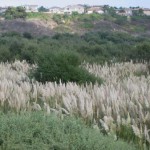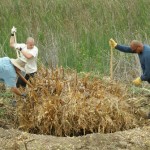Pampas Grass (Cortaderia selloana) vs. Our Lords Candle (Hesperoyucca Whipplei Parishi)
Two plants provide plumes of white that look like large sticks of cotton candy peppering California hillsides. Don’t be fooled! Both have spikey foliage capable of taking a good bite out of you! One is native here and throughout much of the warm-weathered U.S., and it is well adapted to fight drought and fire. The other invaded our hillsides and bears responsibility for a good share of Los Angeles’ fire, flood, slide cycle. Which will you choose to have in your garden?

Hesperoyucca Whipplei Parishi, Our Lords Candle
Coming upon a Yucca Whipplei sparks wonder. Prevalent from the coast to the alpine regions around California, Yucca’s blue-grey, spikey and highly architectural foliage can be as much as 6’ feet in diameter where it has space to grow. A pretty extraordinary wet-to-dry exchange, Yucca actually likes periods of completely dry soil.
Yucca’s blooms are both impressive and unique. Lasting for weeks, hundreds of bell-like flowers form clusters that top 8’ foot spikes. They fill the hills in June, wrapping up their bloom in early July. Check out rocky slopes to catch the last of these magnificent “candles” interspersed with fully blooming Eriogonum fasciculatum (California Buckwheat), and Zauchneria species.
It’s all the more impressive for exactly how much it serves us. Whipplei is designed to withstand drought and fire, and it’s deep roots are ideal for retaining slopes. It’s blooms and roots are edible – deliciously so!
Yucca has its own downsides – harmless quirks, really. After Yucca’s bloom, the full plant dies. Its pups and seeds then create new plants in its place. These pups and plants will take several years to bloom themselves. Also, like Pampas Grass, sharp Yucca leaves can bite and slice, so it’s smart to place them away from paths and walks.
Pampas Grass (Cortaderia selloana)

 Foam-capped waves of the ocean line one side of the Pacific Coast Highway, cliffs of feathery white the other. We see so much Pampas Grass in our wild spaces, it is easy to believe it belongs there. It does not!
Foam-capped waves of the ocean line one side of the Pacific Coast Highway, cliffs of feathery white the other. We see so much Pampas Grass in our wild spaces, it is easy to believe it belongs there. It does not!
Pampas Grass was introduced as an ornamental for erosion control. It was not an entirely illogical choice. It thrives in hot sun, adapts to a wide variety of soils, and resists deer. Now well established in our community, Pampas Grass makes profound contributions to our fire, flood, slide cycles. Why?
- It works itself into the delicate soils of crevices and corners, further dislodging soil.
- It resists many California native fauna – unappealing as a food source, it depletes habitat as it spreads.
- Each of the sparkling, feathery plumes of Pampas Grass can contain 100,000 seed heads. Is it any wonder the California Invasive Plant Council rates it as highly invasive?
Ironically, there is a lovely California native with truly unique blooms and extraordinary architectural foliage that retains slopes with none of the Pampas’ downside.
More Information
- California Invasive Plant Council: Cortaderia Selloana
- Las Pilitas Nursery: Yucca Whipplei Parishii, Our Lords Candle
- GoldenWest College Plant of the Month: Our Lords Candle